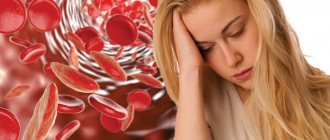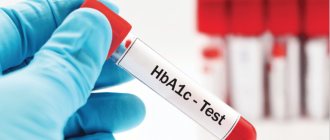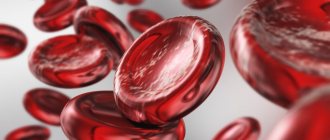Why is hemoglobin needed in the blood and what does iron have to do with it?
Hemoglobin is a special complex protein that is formed in red blood cells when iron atoms enter there. It is hemoglobin that colors blood red. It is entrusted with the most important mission: it transports oxygen from the lungs to organs and tissues. And vice versa: it transports carbon dioxide back to the lungs to be removed from the body. This important protein is also involved in DNA synthesis, maintaining acid-base balance, and organizing proper metabolism.
This is why low hemoglobin is so dangerous: it reduces the efficiency of all internal organs and systems, the vitality and emotional state of a person. And therefore it must be increased to normal.
Normal hemoglobin levels in men, women and children
The level of hemoglobin in a person’s blood depends on gender, age and various physiological characteristics of the body. In men, hemoglobin is normal at values of 135–160 g/l. For women, 120–140 g/l are allowed. In pregnant women, the level of hemoglobin decreases noticeably - up to 110 g/l.
Hemoglobin standards for children vary significantly depending on age. The maximum protein level in newborns in the first month of life is from 140 to 200 g/l. Then it declines quite quickly. In the first six months, the norm is considered to be from 90.5 to 140 g/l. In children under 18 years of age, hemoglobin should be in the range of 110–150 g/l, and then equal to the norms of adults.
How to decipher the units of measurement of hemoglobin in the blood?
Hemoglobin is measured in grams per liter (g/L) or grams per deciliter, i.e. 10 liters (g/dL). To convert g/dl to g/l, simply multiply the first figure by 10.
The level of hemoglobin in the blood is influenced by both the innate characteristics of the body and the person’s lifestyle: level of physical activity, environment, type of diet, and the presence of bad habits.
Why does hemoglobin fall?
Hemoglobin cannot decrease, much less drop sharply, without reason. They can be serious illnesses or situations that cause blood loss: operations, injuries, wounds, internal and external bleeding. In women, a short-term decrease in protein is possible during menstruation, which lasts 5 days or more. The most common causes are lack of iron, folic acid and vitamin B12. However, low hemoglobin can also be a consequence of serious pathologies.
Causes of low hemoglobin:
- failure of the endocrine system;
- gastrointestinal diseases, intestinal pathologies;
- kidney disease;
- problems with the circulatory system;
- pneumonia, tuberculosis, hepatitis and other serious diseases;
- gastritis and neoplasms in the digestive organs;
- oncological diseases;
- exhausting long-term diets, unhealthy diet;
- vitamin deficiency and lack of vitamins and minerals;
- severe stress or prolonged depression;
- multiple pregnancy.
As you can see, the causes of low hemoglobin can be extremely serious and dangerous to health, and therefore this indicator must be monitored regularly and, if necessary, quickly increased.
Causes of anemia
Common causes of low hemoglobin are:
- large blood loss;
- disruption of the formation of new blood cells;
- activation of pathological processes of blood destruction.
Causes of posthemorrhagic anemia
Acute posthemorrhagic anemia is the result of the loss of a large amount of blood in a minimal period of time. The chronic form of this disease is caused by:
- prolonged blood loss;
- polyps, hernias and stomach ulcers;
- kidney diseases;
- malignant tumor neoplasms;
- uterine bleeding;
- disorders of the blood clotting system;
- liver failure, cirrhosis.
What causes hemolytic anemia
All hemolytic anemias occur if “old” red blood cells begin to destroy faster than new ones can form.
The sickle cell form is caused by the synthesis of a defective hemoglobin molecule. The emerging defective molecules form peculiar crystals that stretch the red blood cell, causing the latter to take on the shape of a sickle. Sickle erythrocytes are non-plastic. It leads to increased blood viscosity and blockage of small blood vessels. With their sharp ends they can destroy each other.
Thalassemia is a hereditary disease. It occurs due to a decrease in the rate of hemoglobin formation. Hemoglobin that is not fully formed is unstable. It resembles small inclusions that give the red blood cell the appearance of a target cell.
Deficiency anemias and their causes
Iron deficiency anemia develops for reasons such as:
- lack of iron/increased need for iron (this is why degree 1 anemia is often diagnosed in premature babies and pregnant women);
- chronic blood loss;
- problems associated with the absorption of iron from the gastrointestinal tract, its transportation and disposal.
B12 deficiency anemia is caused by a lack of vitamin B12. The disease can be caused by poor nutrition (refusal to eat meat) or disruption of the absorption of cyanocobalamin in the gastrointestinal tract (parasites, diseases of the small intestine, stomach). Also, symptoms of B12 deficiency anemia can appear while taking hormonal drugs and anticonvulsants.
Folate deficiency anemia is a consequence of a lack of vitamin B9. It is usually observed in pregnant and lactating women, cancer patients, teenage children, premature newborns, liver disease, alcohol abuse, etc.
Causes of hypoplastic anemia
Hypoplastic anemia is manifested by a decrease in the content of all cells in the blood. External and internal factors lead to such a pathological and life-threatening condition:
- vibration and radiation effects on the body;
- serious injuries;
- taking certain medications;
- ingestion of poisons into the body;
- herpes, fungi, bacteria;
- genetic mutations;
- rheumatoid arthritis, lack of elements involved in hematopoietic processes;
- endocrine diseases, etc.
How to find out without tests whether you have low hemoglobin: symptoms of deficiency
Many people are accustomed to ignoring a decrease in hemoglobin. Often, even from doctors, you can hear the phrase: “I have lived with low hemoglobin all my life, and nothing.” However, this does not mean that there is no need to look for the cause of the decrease in hemoglobin and eliminate it.
A low level of hemoglobin in the blood gives very specific symptoms, so even a layman can notice them. Here are some of the most common signs of its decline.
Signs of low hemoglobin:
- constant feeling of fatigue, drowsiness, fatigue;
- shortness of breath during physical exertion and normal climbing of stairs;
- regular headaches;
- low blood pressure;
- dry and brittle nails;
- dryness and active hair loss;
- disruption of the gastrointestinal tract;
- pale dry skin, possible peeling;
- tinnitus and dizziness;
- decreased appetite or perverted taste preferences: desire to eat chalk, raw dough or meat, smell paint or gasoline;
- muscle pain, freezing hands and feet;
- regular menstrual irregularities in women;
- decreased potency in men;
- frequent colds and viral diseases.
These symptoms, especially if there are several of them and they are observed for a long time, indicate that the hemoglobin in the blood is already quite reduced. In severe cases, the person may even lose consciousness. This means that you need to look for a solution and take action quickly.
When to donate blood for hemoglobin
The reason to consult a physician or hematologist and take a blood test for hemoglobin level may be the detection of the above symptoms - one or more, a serious deterioration in health after an illness, significant blood loss due to injury or during surgery, adherence to a strict diet, an identified disease blood from close relatives, pregnancy.
A slight decrease may not be noticeable to humans. To prevent changes in hemoglobin levels from becoming a surprise, it is better to keep the situation under control: get your blood tested 1-2 times a year, and if necessary, consult a hematologist.
Consequences of increased hemoglobin in women
High hemoglobin levels are dangerous for women due to complications that affect the functioning of various systems and organs. Thus, an increase in blood viscosity leads to the formation of clots, which can cause bleeding, pulmonary thromboembolism, stroke, heart attack or thrombosis. Any of these conditions requires immediate assistance from medical personnel, since it threatens the life and health of the patient.
Hyperhemoglobinemia is especially dangerous for people with chronic diseases of the lungs and cardiovascular system, since their risk of developing thrombosis increases several times. Timely monitoring of Hb level concentrations is necessary during and after treatment of pathologies.
What is anemia and how to diagnose it
Anemia (or anemia) is a decrease in hemoglobin and a decrease in the number of red blood cells in the blood. This condition leads to the fact that organs and tissues do not receive the required amount of oxygen, metabolic processes and the general well-being of a person worsen. The first symptoms may be fatigue, shortness of breath, loss of appetite, dry skin, brittle hair and nails and other signs that are not always immediately linked into a single picture.
This is why it is extremely difficult to diagnose anemia on your own, and it is impossible to do this based only on laboratory test results. To make a diagnosis, doctors not only look at the level of hemoglobin and iron, but also check the level of cholesterol, glucose, creatinine, uric acid and electrolytes, assess the general condition of the patient and his internal organs, and conduct a comprehensive diagnosis.
Severity of anemia:
- Mild anemia:
the level of hemoglobin in the blood is less than normal, but more than 100 g/l. The symptoms are subtle, so a person rarely turns to specialists at this stage of the disease. - Moderate anemia:
hemoglobin level in the blood is from 66 to 100 g/l. Frequent dizziness, nausea, drowsiness appear, dryness and cracks in the skin become noticeable. - Severe anemia:
hemoglobin level in the blood is less than 66 g/l. Critical condition, clouding and loss of consciousness, cold hands, fainting. Emergency hospitalization is required as there is a serious threat to life.
However, it is worth consulting at least with a therapist when the indicator drops below 120 g/l in women and below 135 g/l in men, without waiting for the condition to worsen.
How dangerous is anemia for humans?
This disease can be considered both dangerous and relatively harmless at the same time. On the one hand, mild anemia occurs quite often and can be treated without problems. On the other hand, long-term iron deficiency and low hemoglobin levels place a serious burden on the body. Severe anemia can have serious consequences:
- malfunctions of the kidneys, liver and other internal organs;
- diseases of the cardiovascular system;
- cognitive impairment;
- increased risk of falls and, as a result, injuries and fractures;
- oxygen starvation (hypoxia), risk of myocardial infarction and stroke;
- exacerbation of chronic diseases;
- deterioration of the reproductive system;
- anemic coma or death.
However, there is no need to panic. Pathologies and complications tend to develop if hemoglobin is greatly reduced for several years. Regular monitoring and testing of tests 1-2 times a year will be sufficient prevention and will help to quickly identify the problem and begin treatment.
It is important for pregnant women and young children to monitor the level of hemoglobin in the blood and prevent it from decreasing. Otherwise, there is a risk of pregnancy complications, premature birth and impaired fetal development - a malfunction of the brain, nervous and respiratory systems. In young children, a lack of hemoglobin can cause delayed intellectual development.
High hemoglobin in women - what does it mean and what should be done
Doctors are often asked the question - what does it mean if a woman has increased hemoglobin? As a rule, this condition is caused by a lack of oxygen in the blood. In order to compensate, the body begins to actively produce red blood cells containing Hb molecules.
To prevent the risk of developing complications in the form of thrombosis, mandatory correction of high hemoglobin levels is necessary. If such a condition is caused by external factors, then when they are eliminated, the Hb value returns to normal. In a situation where hyperhemoglobinemia is a concomitant symptom of the disease, initial elimination of the underlying pathology is necessary.
Reasons for the increase
Factors that cause an increase in hemoglobin levels can be exogenous (external) or endogenous (internal).
Exogenous causes. An increase in hemoglobin levels may be associated with a person’s type of activity. Thus, pilots, residents of high mountains and climbers who spend significant time at high altitudes experience hypoxia. Therefore, immediately after the flight, the Hb concentration will be higher than normal. Taking certain medications, such as steroids, also affects this laboratory indicator.
During long-term training with heavy loads, a huge amount of oxygen is consumed, which, with the correct technique, is compensated by frequent and deep breathing. If technology is violated, an increase in hemoglobin levels is observed in the body.
Endogenous causes. Diabetes mellitus and mental disorders accompanied by stress reactions can also cause Hb deviations from the norm. And in the case of a benign tumor process of the circulatory system (Vaquez disease), an increase in the concentration of red blood cells becomes malignant.
When taking medications that lead to excessive absorption of iron ions in the blood against the background of malfunctions of the enzymatic system, the Hb level increases.
Reasons for the downgrade
Low Hb concentrations are observed against the background of the following pathological conditions:
- anemia of various types;
- failures of hemoglobin synthesis processes;
- liver diseases;
- ulcers of the stomach and duodenum;
- chronic kidney disease, which results in a decrease in the concentration of the hormone erythropoiesin, the main role of which is the activation of the formation of red blood cells in the bone marrow;
- hypofunction of the thyroid gland;
- blood hemolysis - destruction of red blood cells;
- oncological diseases accompanied by metastases to the bone marrow;
- chronic pathologies of connective tissue;
- infectious process.
Read further: Tables of norms with explanations of indicators in a biochemical blood test
How to increase hemoglobin
It is quite difficult to quickly increase hemoglobin levels. This process usually takes about a month. You should not assume that self-prescribed vitamins or increased nutrition with meat will work miracles.
The most important thing in the process of normalizing hemoglobin is not to throw iron into the body, but to look for the causes of the malaise. It is important to promptly and correctly diagnose the disease that causes a decrease in hemoglobin, and work with it first. In case of severe blood loss or blood diseases, the patient is given a transfusion of blood or its individual components. This helps replenish its volume.
And already in combination with professional treatment, taking iron-containing medications and adjusting the diet will give a good effect, help avoid complications and improve the patient’s condition.
Important:
Before starting treatment, it is necessary to undergo a medical examination, do a blood test and obtain consultations from all specialized doctors, depending on the diagnosis. Self-medication is unacceptable. All procedures and prescriptions must be agreed with a doctor and regularly monitored by him.
And to prevent iron deficiency and decrease in hemoglobin, it is recommended to adjust your diet and include iron-containing foods. Approximate norms for iron consumption per day are 10–12 mg for men and 20–30 mg for women. More precise figures depend on the person's condition.
Treatment of anemia in children and adults
To get rid of the symptoms of anemia, you need to eliminate the factor that provoked the decrease in hemoglobin. So, if the pathological condition is associated with the presence of parasites in the body, you need to get rid of them, if with poor nutrition, start following a diet, if with a malignant/benign tumor, it should be removed.
In other words, treatment of low hemoglobin in men, women and children may be conservative or require specialized surgical procedures. Usually, in order to improve the condition of patients and reduce the severity of negative symptoms, doctors adhere to the following therapeutic regimen:
- drugs are prescribed that can compensate for the resulting deficiency - B12 for B12-deficiency anemia, iron for iron deficiency, B9 for folate deficiency, etc.;
- normalize the level of red blood cells. This can be accomplished by transfusion of red blood cells or washing of red blood cells. However, these measures when providing assistance to people with low hemoglobin levels are extreme and are carried out only if the resulting disease is life-threatening.
Treatment of acute and chronic posthemorrhagic anemia
Treatment of the acute form of posthemorrhagic anemia is carried out in a hospital or hematology clinic
. The medications prescribed to the patient help normalize the amount of blood and the level of formed elements, and are also aimed at preventing relapses of the disease. Taking into account the amount of blood lost, the patient may need a transfusion, the introduction of blood substitutes or red blood cells.
As for the chronic form of this type of anemia, it is impossible to get rid of its symptoms without eliminating the cause. After the factor that provoked the pathological condition has been eliminated, the patient will be prescribed a diet that includes eating foods rich in iron. Medicines that can be used are Sorbifer Durules, Ferrum-Lek, vitamins B12 and B9, etc.
Treatment of sickle cell anemia
The main goal of therapeutic measures when it comes to a patient with sickle cell anemia is to prevent the development of hemolytic crises. To do this, the patient must avoid being in places with low oxygen levels. In parallel, blood substitutes and red blood cell infusions can be used.
Elimination of iron deficiency anemia
Treatment of iron deficiency anemia includes eating foods rich in iron and treating existing gastrointestinal diseases. The patient should regularly eat:
- cheeses;
- porridge;
- chicken eggs;
- meat;
- dairy products.
Iron supplements can also help quickly get rid of the symptoms of anemia. The tablets usually used are “Ferrum-Lek”, “Totem”, “Sorbifer Durules”, etc. Injections are prescribed only for severe forms of the disease. It is important that the medicine used does not cause problems with the gastrointestinal tract. If constipation or flatulence occurs, the product needs to be replaced.
Treatment of B12 deficiency anemia
Complex therapy of gastrointestinal diseases and adherence to the principles of proper nutrition help eliminate the manifestations of B12-deficiency anemia. Most often, patients are prescribed vitamin B12 injections. They allow you to quickly restore hematopoietic processes in the bone marrow.
How to get rid of folate deficiency anemia
Folate deficiency anemia is treated by taking vitamin B9 and following a diet. The patient should include foods that contain high amounts of folic acid in their diet. This means citrus fruits, vegetables, herbs, asparagus, nuts, seeds, tomatoes, watermelons, corn, avocados, eggs, animal liver, cod liver, cereals, grain bread.
Treatment of hypoplastic anemia
A hematologist treats hypoplastic anemia. Depending on the age, gender and condition of the patient, he can use different methods - bone marrow transplantation, stimulation of hematopoietic processes, blood transfusion, etc.
Which foods contain a lot of iron to increase hemoglobin?
- Dried mushrooms.
A product that can significantly increase iron levels in the body. Just 50 g of dried mushrooms per day will help replenish the iron content in the blood. Not everyone can eat them every day, but periodically including mushrooms in your diet is very useful.
- Red meat.
The dark color of the product indicates a high iron content. For example, a steamed beef cutlet weighing 100 g contains approximately 2.7 mg of iron - almost 15% of the daily requirement. For comparison: in the same turkey cutlet the amount of iron is about 0.7 mg.
- Pumpkin seeds.
An excellent source of iron: 200 g of the product easily covers the daily requirement. But you shouldn’t get carried away with pumpkin seeds: they are very high in calories and can cause disruptions in the gastrointestinal tract. But a small handful of seeds in a salad or hot dish will be very useful.
- Offal.
In terms of the content of iron and other useful microelements, offal easily surpasses meat. 100 g of cooked beef liver contains 36% of the daily iron requirement.
- Buckwheat and rolled oats.
A couple more important foods that can boost your iron levels. A 100 g serving of buckwheat or rolled oats will provide the body with approximately 25% of the beneficial element.
- Legumes.
An essential part of the diet for vegetarians and vegans, legumes are not only rich in iron, but also very filling. A cup of boiled lentils, for example, will cover approximately 35% of the daily requirement for iron, and a glass of boiled beans will cover 20%.
- Dark chocolate.
Perhaps the favorite product of those who seek to increase their hemoglobin levels. The main thing is to choose chocolate with a cocoa content of at least 70% and eat at least ¼ bar (25 g) per day. This will help compensate for about 17% of the daily iron requirement and give you a good mood due to the “happiness hormone”.
For iron deficiency and low hemoglobin, the following foods are also recommended: eggs (especially the yolk), quinoa, almonds, walnuts, peeled apples, pomegranate, grapes, raspberries, rose hips, beets, freshly squeezed fruit and vegetable juices, seafood - caviar, fish, oysters It is important that the diet is balanced and that foods contain a variety of nutrients and vitamins.
How to make iron better absorbed
To increase hemoglobin, it is not enough to simply include iron-containing foods in your diet. It is important that the nutrients are absorbed as much as possible and are beneficial. To do this, you should know which products can and cannot be combined with each other.
Iron is best absorbed in the presence of vitamins C and A. That's why seafood with lemon is not only tasty, but also incredibly healthy. A few drops of lemon can be added to salads and other dishes. Almost all fresh vegetables and fruits, such as bell peppers, are rich in vitamin C. Vitamin A is found in fish, oil, vegetables and orange fruits.
It is important to ensure that the body receives folic acid, which takes part in the synthesis of red blood cells. Therefore, you should regularly eat beef, green salad, avocados, legumes, rice, peanuts and other foods high in folic acid.
But calcium and casein (milk protein) reduce the absorption of iron, so you should not consume dairy and fermented milk products and cheeses along with vegetable and meat dishes. Wheat and other grains have a negative effect on the absorption of iron. So it’s better to eat meat without bread, and use vegetables rather than pasta as a side dish. Among the foods that can provoke hemoglobin deficiency: tea, coffee and persimmons (contain tannins), bread, soy, canned food, soda, processed cheese. Therefore, you should not abuse them.
Can there be too much iron in the body?
Maybe. An excess of iron is just as harmful to the body as its deficiency. It causes fibrosis of organs and tissues. The pancreas, liver and heart are most often affected. However, it is impossible to achieve an excess of iron through diet alone. The pathology is often due to genetic predisposition and improper or uncontrolled use of iron-containing drugs.
What is an increase in hemoglobin called?
An increase in the number of red blood cells and an increase in hemoglobin is called erythrocytosis. Its characteristic symptoms: nosebleeds, headaches and dizziness, fatigue. Erythrocytosis, in turn, can be a sign of various diseases, which only a doctor can determine.
What does it mean if hemoglobin is elevated?
High hemoglobin levels can be caused by dehydration, smoking, lung cancer, heart disease and other pathologies. Elevated hemoglobin sometimes indicates the presence of a rare disease - polycythemia. When this happens, the body produces too many red blood cells, which can lead to blood clots, heart attacks and strokes. This is a very serious disease that is important to identify and control early throughout your life.
Symptoms of high hemoglobin
Initially, it is necessary to sort out what complaints does a woman have with increased hemoglobin?
The condition of increased hemoglobin is called hyperhemoglobinemia and very often occurs without the manifestation of clinical signs. In most cases, high hemoglobin in women and men is detected only during a routine general clinical examination. In some cases, hyperhemoglobinemia is accompanied by the following symptoms:
- increased blood pressure and swollen veins;
- a feeling of aching in bones and joints;
- decreased performance;
- weakness and drowsiness;
- shortness of breath even when walking calmly;
- slight blueness of the fingertips;
- pallor or flushing of the face;
- losing weight for no apparent reason;
- decreased concentration and absent-mindedness;
- long and painful menstruation;
- neurotic disorders, psychoses, insomnia, depression.
Often the causes of high hemoglobin levels in women and men are a concomitant disease. In this case, the symptoms of hyperhemoglobinemia are similar to the clinical manifestations of the underlying pathology. This fact explains the difficulties for differential diagnosis of hyperhemoglobinemia itself and identifying its causes.
Hemoglobin during pregnancy
During pregnancy, elevated hemoglobin is extremely rare. As a rule, a single increase in Hb concentration is not significant, since the levels of all indicators change during the day against the background of physical or emotional activity. However, consistently high levels may indicate a lack of B vitamins or the development of a pathological process. In this case, a comprehensive examination of the patient is prescribed to eliminate the hyperhemoglobinemia condition as quickly as possible. This is necessary to reduce the risk of developing thrombosis and fetal hypoxia.
Pregnant women are more often characterized by a state of hypohemoglobinemia - a deficiency of hemoglobin levels against the background of blood thinning, as a result of an increase in its volume.
For early diagnosis of deviations from the norm when planning to conceive a child, a course of preventive measures is recommended to prevent a decrease in Hb concentration. This will significantly reduce the risk of developing any type of anemia.
Read further: What is hemoglobin in the blood, its types, how is it tested. How does alcohol affect? The influence of periodic women's days
How to maintain normal hemoglobin levels
For a healthy person without congenital pathologies, it is important to monitor the daily routine, drink enough water, eat a balanced diet, include foods rich in iron and vitamins in the diet, lead an active lifestyle and periodically undergo general and biochemical blood tests.
These tips may seem obvious and even banal to you, but they will help prevent a decrease in hemoglobin, the development of anemia and other diseases, and improve your well-being and quality of life.
This material summarizes the best research on evidence-based medicine over the years. However, it is for informational purposes only, is not intended to prescribe treatment, and cannot be used as a direct guide to action.
Prevention of elevated hemoglobin
Preventive measures against increasing the concentration of Hb in the blood consist of maintaining a healthy lifestyle:
- cessation of alcohol abuse, smoking and psychotropic drugs;
- maintaining a proper diet;
- drinking large amounts of clean water without gas;
- limiting physical and emotional overload;
- health status monitoring – annual scheduled examinations and maintenance therapy for chronic diseases.










